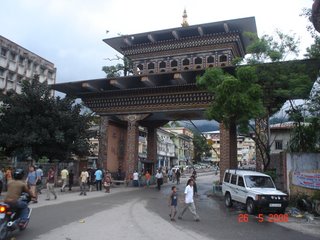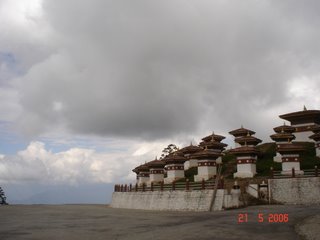
After a leisurely breakfast at the Hotel, we started to settle our dues. The pretty receptionist presented us with a hefty bill and we figured out that the terrible tasting buffet the previous night had cost about rs 300 per head. Quick tip – avoid eating in the fancy hotels where you stay. The standalone restaurants have tastier and cheaper food. If you do have to eat at the hotel, avoid the buffet and order a la carte.
Wiser and poorer, we left for Thimphu. Another thing about road trips is you need to carry sufficient tapes or cds. W and S had been listening to songs from Aashiqui and Sadak for the last two days. While they were clearly Rajesh’s personal favourites and both had not protested much, they were quite glad when I took out the three tapes I had carried with me.
As usual all of us sat enthralled by the view. Rajesh pulled over at a rope bridge and let us take plenty of snaps. He had clearly made up his mind that this lot was yet to get over the initial feel of the place and would click away till the memory chip’s capacity constraints began to set in.
After a couple of hours, we were at the outskirts of Thimphu and stopped at Simtoka Dzong, an ancient structure, now in ruins and being restored. The central hall had colourful paintings of various monks and incarnations of Buddha. Since it was a Sunday, only a handful of trainee boy monks were in the place and there was something eerie about the jumble of bricks in the many rooms being lit by occasional patches of sunlight. After a few quick snaps with the monks, we left.
The next stop was a more living and breathing Chorten/monastery where devotees were busy turning gigantic prayer wheels. Prayer wheels are a wonderful concept that Buddhists have and apart from lining the walls of all Lakhangs , they also grace the chortens and sometimes shop fronts. Most people turn each prayer wheel lining the walls of the Lakhang, thus slowing their pace as they circle the structure. Same was the case at Changangkha Lakhang, our next stop. The sanctum sanctorum at this Lakhang was quite reminiscent of Hindu temples. The monk gave us some holy water and touched our heads with a piece of metal. Devotees prostrated in front the large statue of Buddha. Same wine, new bottles. Changangkha also has a great view of Thimphu, atleast better than the view from the telecom tower to which we were headed.
On the way was a stop at the Takin Reserve. Takins are Bhutan’s national animals. A colourful bit of local myth says that they were created when the locals pestered one of the more eccentric monks for a miracle. The good man asked for a cow and a goat and devoured the two <> and then created an animal with the cow’s body and the goat’s head. Thus emerged the Takin, with an IQ of roughly 25 since clearly the mutuation had been too much to handle for the animal. Befuddled modern day taxonomists classify this animal in its own class on account of various reasons other than appearance. Sometime in the past, when Bhutan decided to add a zoo to its list of tourist spots, the Takins were among the star attractions. However, it was later decided that zoos are a bit cruel on animals and the animals were let loose. The Takins apparently were at a loss on how to react and spent their time regularly being killed at traffic accidents and such, till finally the Bhutanese decided to create a wild life reserve to save the Takins from themselves. The reserve is about 8 acres and tourists can walk around a wire fence through which the Takins can be seen. All of us did exactly that, armed with our cameras. I have a nice Sony 4.1 mega pixel camera with much functionality. One of those functionalities is a switch that allows me to turn off the flash. Something I did not discover till later. So when one of the Takins finally came close enough for a decent shot, I let my shutterbug instincts lose. The stupid flash in my camera scared the Takin out of its wits. The bulky Takin sprang towards me with surprising agility. Then, I got scared out of my wits and inspite of knowing that a strong fence separated us, sprang back with even more surprising agility. At the end of this happy performance, a decent distance separated both Takin and self from each other and I decided not to take snaps of any more animals.
Shaken and stirred, I looked forward to the calmer environs of the telecom tower. This is one of those U.S. type attractions – completely insipid, created to keep the tourist happy that they have more one place to tick off on their checklist and with mediocre photo opportunities. All of us dutifully posed for a snap. W went one step beyond and helped a couple of young Bhutanese women struggling with the lyrics of a Bollywood song.
On the way back was our big Royalty moment. The king’s cavalcade, comprising his car with the license plate reading ‘Bhutan’ and a smart police vehicle led the way. The other cars on the road stopped. Like good tourists we gawked as the Queen’s entourage followed at a respectful distance. S’s theory was that since the royalty was another star attraction, possibly there are plenty of such cars whizzing up and down to give tourists a bang for their buck. My theory was that with a population of roughly 700000 people, everyone is bound to bump into everyone else over a 10-day period. All of us were thrilled though to see in flesh and blood, albeit through tainted glasses, the man whose picture we had seen in every single establishment in Bhutan.
The next stop was the Decchen Phodrang Monastery. This was again bereft of adult supervision being a Sunday. The boisterous bunch of child monks though made up with their enthusiasm and eagerness to get snapped. W obliged and clicked as many pictures as possible. The monastery itself was beautiful, perched on a hill, overlooking rice fields. You could just sit on one of the roofs and watch the countryside for hours.
Finally it was time to tackle LP’s number one spot – the Drashi Choe Dzong. This is the main admin office of the country, with the King and a couple of senior members of his cabinet having offices here. The Parliament is located just across, separated by a river. The Dzong is majestic to say the least. Unfortunately we could not enter the premises since we had to have permits and permits are given only to Bhutanese tour guides. The simplest solution would have been to tell the hotel to arrange for a tour guide for an hour, but we did not have that kind of time.
Our stay that night was at the Wangchuk Hotel, located close to Norzin and Chorten Lams, Thimphu’s main market area. Lam means ‘road’ but to the Bhutanese sullying places by categorizing them under proper names is probably a sin. Whenever you stop to ask people for directions to a place, they never tell you which roads to take, instead give you directions based on various landmarks. At any rate, Wangchuk Hotel was located conveniently close to the shopping center and we could just pop out and pick up bargains. Which is exactly what P and self did while the guys decided to catch up on their sleep.
Shopping in Thimphu involves a decent bit of bargaining. Unfortunately shops close by eight on Sundays and hence at 8.15 we found ourselves on practically deserted streets. The next step was to find a decent place for dinner that served momos. The hotel’s sulky waiter had sulked throughout tea and clearly informed us that we would not get momos. In the event, we ended up having dinner at the Zone 1 pub. They served pizzas instead of momos but the cheerful owner played an extremely funny video on Bushisms compiled by Slate magazine and another equally funny Robin Williams stand up comedy show. I sat transfixed watching TV after months of watching largely tamil and hindi music channels in Chennai. I went to sleep happy and contented.






